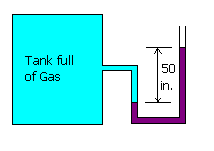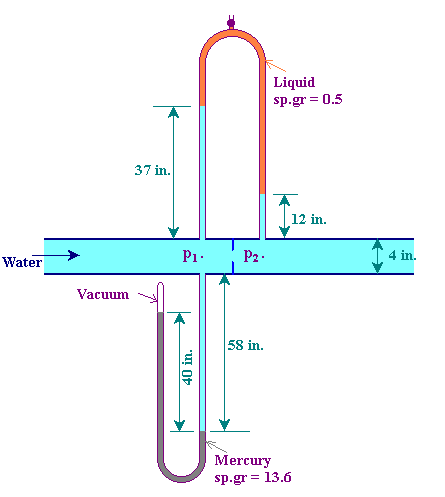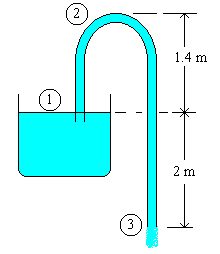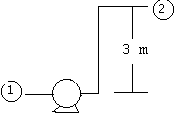Part A (12 x 2 = 24 Marks)
Fluid which obeys the Newton's law of viscosity:
Examples: water, air, kerosene.
(a) Bingham plastic fluid: Tooth paste, gels, sewage sludge
(b) Thixotropic fluid: paint
lb-ft-sec units: 10 cP = 10 x 10-3 kg/m.sec = 0.01 x 2.203/(3.281 x 1) lb/ft.sec = 6.713 lb/ft.sec
S.I: 10 cP = 0.01 kg/m.sec
Bulk modulus (K) = (change in pressure) / (volumetric strain)
Volumetric strain is the change in volume divided by the original volume. Therefore,
(change in volume) / (original volume) = (change in pressure) / (bulk modulus)
i.e., -dV/V = dp/K Negative sign for dV indicates the volume decreases as pressure increases.
In the limit, as dp tends to 0,
K = -V dp/dV
In terms of density, K = rdp/dr
Bulk modulus has the units of pressure; N/m2.
h = 4scos(q)/(rgd)
h = 4 x 0.514 x cos(140)/(13.6 x 1000 x 9.812 x 3 x 10-3)
i.e., h = 3.93 mm
Pressure at a point is same in all directions. This is Pascal's law. This applies to fluid at rest
-20 psig = -20 + 14.7 = -5.3 psia. The minimum possible pressure is only 0 psia. Therefore, the given gauge pressure is an impossible one.
 The fluid in the manometer (shown in figure) is ethyl iodide with sp.gr = 1.93.
The manometeric fluid height difference is 50 in. What is the gauge
pressure in the tank? What is the absolute pressure in the tank?
The fluid in the manometer (shown in figure) is ethyl iodide with sp.gr = 1.93.
The manometeric fluid height difference is 50 in. What is the gauge
pressure in the tank? What is the absolute pressure in the tank?
DP = rgh = 1.93 x 1000 x 9.812 x 50 x 0.0254 = 24.05 kN/m2(g) = (101.3 + 24.05) kN/m2(a) = 125.35 kN/m2(a)
Ideal fluid is a hypothetical fluid which is assumed to have a viscoisty of zero, and incompressible.
Reynolds number of an ideal fluid is infinity.
u = 2x2 + zy
v = -2xy + 3y2 + 3zy
w = -1.5z2 - 2xz - 6yz.
where u, v and w are velocity components in x, y and z directions respectively.
¶u/¶x = 4x
¶v/¶y = -2x + 6y + 3z
¶w/¶z = -3z - 2x - 6y
¶u/¶x + ¶v/¶y + ¶w/¶z = 0.
Therefore, continuity equation is satisfied.

Flow is steady, inviscid and incompressible.
There are no addition of energy in between the the sections considered.
Part B (3 x 12 = 36 Marks)
(ii) for the atmosphere in which the temperature decreases with altitude at a constant rate.
(i) Variation of pressure with distance is given by,
dp/dz = -rg --> 1
For adiabatic atmosphere, pVg = constant
i.e., p/rg = constant
p/rg = p1/r1g
r = r1(p/p1)g = B pg --> 2
where
B is a constant = r1/p1g
Substituting from equn.2 in equn.1,
dp/dz = -B pgg
Separating the varaiables and integrating,
-dp/pg = Bg dz
[1/(g - 1)] p-g+1 = Bgz + C
where C is a constant.
The constant C can be eliminated by substituting the initial conditions; that when z = z1, p = p1
C = [1/(g - 1)] p1-g+1 - Bgz1
Therefore, [1/(g - 1)] p-g+1 = Bgz + [1/(g - 1)] p1-g+1 - Bgz1
(ii) For the atmosphere in which the temperature decreases with height at a constant rate, T = To - Cz
where To is the temperature at the ground level; and C is the rate of change of temperature with height(z).
dp/dz = -rg = -(pM/RT)g = -pM/[R(To + Cz)]
where M is the molecular weight of air.
Separating the variables,
dp/p = -M/[R(To + Cz)] dz
ln p = -M/(RC) ln (To + Cz) + D
where D is a constant;
The constant D can be eliminated from the substitution of initial conditions, p = p1 when z = z1
D = ln p1 + M/(RC) ln (To + Cz1)
Therefore, ln p/p1 = M/(RC) ln [(To + Cz1)/(To + Cz)]
Or
Variation of pressure with distance is given by,
dp/dz = -rg --> 1
Assuming that air is following ideal gas relationship, r-5 p.
Substituting for r in Equn.1, dp/p = -1.255 x 10-5 x 9.812 dz Integrating between the limits: (z1 = 0, p1 = 1 atm = 1.01325 x 105 N/m2; and when z2 = 10,000 ft = 3048 m, p2 = ?)
ln (p2/p1) = -1.255 x 10-5 x 9.812 x (z2 - z1)
i.e.,
p2/1.01325 x 105 = e-0.3753 = 0.687
Therefore, p2 = 0.6962 x 105 N/m2 = 0.687 atm (a).
(ii) What is the error if the movement of the fluid in the larger dia leg is ignored?
(iii) What factors influence the sensitivity of manometer?
Or
 A closed-U-tube manometer filled with mercury is attached to the underside of a line
carrying water, as shown in figure. At a point directly above the closed-U-tube manometer
tap, the upstream tap of an inverted U tube is located. The inverted-U-tube manometer is
filled with a liquid of specific gravity 0.5. What are p1 and p2 in
psia?
A closed-U-tube manometer filled with mercury is attached to the underside of a line
carrying water, as shown in figure. At a point directly above the closed-U-tube manometer
tap, the upstream tap of an inverted U tube is located. The inverted-U-tube manometer is
filled with a liquid of specific gravity 0.5. What are p1 and p2 in
psia?
Balance for the mercury manometer:
40 x 13.6 = p1 + (58 + 2) x 1 p1 = 40 x 13.6 - 60 inch water = 12.294 m water = 17.485 psia
Balance for the inverted manometer:
p1 - 39 x 1 = p2 - 14 x 1 - 25 x 0.5
p1 - p2 = 25 x 1 - 25 x 0.5 = 12.5 inch water = 0.3175 m water = 0.03074 atm = 0.452 psi.
Therefore, p2 = 17.485 - 0.452 = 17.006 psia.
(ii) If the peak point of the siphon is 1.4 m above the water surface in the tank, estimate the pressure of fluid at the point of siphon.
(iii) Estimate the maximum distance between water surface and the peak point of siphon, so that the flow is not getting disturbed.
The given problem is shown as a diagram:

Bernoulli's equation for frictionless flow is:

(a) Applying Bernoulli's equation for the points 1 and 3, ( i.e. comparing the energy levels for the fluid in the tank surface and at the discharge point of tube)
p1 = 0 N/m2(g)
p3 = 0 N/m2(g)
z1 = 0 m
z3 = -2 m
Since the rate of fall of liquid level in the tank is almost negligible,
v1 = 0 m/sec.
Therefore,
0 + 0 + 0 = 0 + (v32 / 2g) - 2
v3 = (2 x 2g)0.5 = 6.265 m/sec
Discharge Q = (p/4)D2 v = (p/4) x 0.032 x 6.265 = 0.00443 m3/sec = 15.94 m3/hr
(b) Applying Bernoulli's equation for the points 1 and 2, ( i.e. comparing the energy levels for the fluid at the tank surface to the peak point of siphon)
p1 = 0 N/m2(g)
z2 = 1.4 m
v2 = v3 = 6.265 m/sec (since the cross sectional area of sections 2 and 3 are the same)
0 + 0 + 0 = p2 / (rg) + 6.2652 / (2g) + 1.4
p2 / (rg) = -3.4 m
p2 = -3.4 x 1000 x 9.812 N/m2(g) = -33360.8 N/m2(g)
Absolute pressure at point 2 = 101325 - 33360.8 = 67964.2 N/m2(a)
(c) Maximum height is obtained by setting p2 = 316.6 N/m2(a):
Applying Bernoulli's equation between points 1 and 2,
1.01325 x 105/(1000 x 9.812) + 0 + 0 = 316.6/(1000 x 9.812) + 6.2652/(2g) + hmax
Therefore, hmax = 8.294 meter
Or
 Point 1:
Point 1:
Cross-sectional area = 15 x 10-4 m2
Fluid Velocity = 1 m/s
Point 2:
Cross-sectional area = 5 x 10-4 m2
Elevation above point 1 = 3 m
Other Data:
Power delivered by the pump = 7.5 W
assume efficiency = 100%)
Predict whether flow is taking place from point 1 to 2 or from 2 to 1.
By equation of continuity,
A1v1 = A2v2
Therefore, v2 = 15 x 1 / 5 = 3 m/sec.
Mass flow rate = r Q = 1000 x 15 x 10-4 x 1 = 1.5 kg/sec.
Pump head = 7.5 / (1.5 x 9.812) = 0.51 m
Assuming flow is from 1 to 2, we can write the Bernoulli equation between 1 and 2 as,
where 'q' is the work done by pump and 'w' is the work done by the fluid, and h is the head loss by friction.
Substituting for the known quantites,
1.25 x 105/(1000 x 9.812) + 12/(2 x 9.812) = 1.05 x 105/(1000 x 9.812) + 32/(2 x 9.812) + 3 + h + 0 - 0.51
12.74 + 0.051 + 0 = 10.7 + 0.459 + 3 + h - 0.51
Therefore, h = -0.858 m.
For a possible flow, h can not be negative. Therefore, the assumed direction is not correct.
Let us rework for flow from 2 to 1:
Then,
1.05 x 105/(1000 x 9.812) + 32/(2 x 9.812) + 3 = 1.25 x 105/(1000 x 9.812) + 12/(2 x 9.812) + h + 0 - 0.51
10.7 + 0.459 + 3 = 12.74 + 0.051 + 0 + h - 0.51
Therefore, h = 1.419 m, which is a positive quantity; therefore, flow is from 2 to 1.

